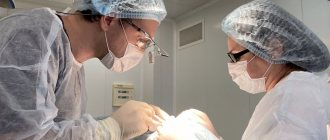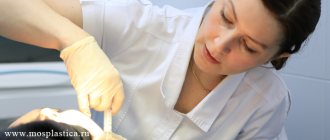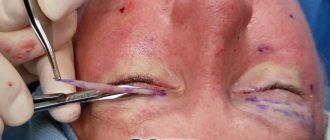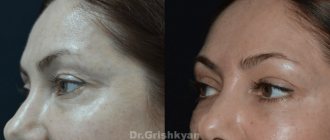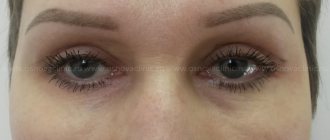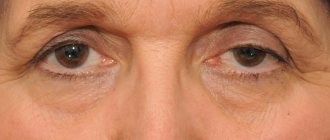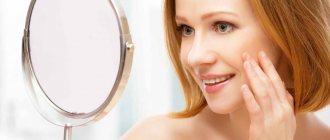Blepharoplasty is a serious plastic surgery with a pronounced rejuvenating effect. It will not be possible to see the final result immediately after the operation; to do this, you will have to wait until the rehabilitation period is over. In order for your eyes to quickly take on their attractive appearance, it is very important to seriously follow the doctor’s recommendations during the postoperative period.
For a better recovery, it is important to properly prepare for surgery. This means that you need to quit smoking and alcohol at least half a month before the procedure. You should also stop taking blood thinning medications. If you catch a cold or get sick immediately before plastic surgery, it is very important to inform your surgeon about this. He may decide to postpone the operation until the patient has fully recovered.
Answers to basic questions
When are the stitches removed?
On the first day, the woman/man is under the supervision of nurses and a doctor for 1–3 hours. The sutures are removed after 4–7 days. It all depends on the depth of the cut.
Will scars be visible on the eyelids?
Sutures are placed as close to the eyelash line as possible. After lower blepharoplasty they are almost invisible. After the end of the recovery period, they completely resolve.
After upper eyelid surgery, the sutures are more noticeable. They won't disappear in a month. It should take 12 weeks for the color to completely smooth out and even out. If scars remain after 3 months, physical therapy is performed to remove them.
When can you wear makeup after blepharoplasty?
Cosmetics can be applied 14 days after surgery. To avoid allergic reactions, since the skin is very sensitive during this period, select hypoallergenic cosmetics. Choose products from reliable brands recommended by your doctor.
Cosmetics should be light and soft. It is strictly forbidden to apply to the crust covering the surface of the wound, or to areas of irritation.
How long does it take to fully recover after blepharoplasty?
Takes 10–12 weeks. Photos of rehabilitation by day with explanations below.
A person can go home on the first day after the procedure. Severe swelling appears above and below the eyes, which can spread to the nose and area around the eyes.
2–3 days after the cosmetic procedure the swelling is slightly less. Take antiseptic drops and perform eye exercises.
A preventive examination is carried out on days 4–5. Contact lenses can be used.
On day 5, hematomas and swelling begin to subside. The skin under the patches itches. But you shouldn’t touch your eyes with your hands, much less scratch them.
6-7 days - the sutures are removed. The eye swells a little. The cyanosis disappears. Some sutures are self-dissolving, you need to come to an appointment.
On the 10th day, hemorrhages resolve. It is allowed to use cosmetics if the stitches dissolve.
After 2 weeks, the effect of the operation is almost invisible. The stitches are coming through.
40–45 days - recovery comes to an end. The effect of surgery remains noticeable.
By the end of 3 months, the sutures are completely dissolved.
What are the restrictions after blepharoplasty?
Blepharoplasty is a type of plastic surgery to correct cosmetic imperfections. 90% of success depends on the correct behavior of patients, so the following restrictions should be adhered to:
- sleep in a reclining position to prevent swelling;
- do not lift heavy objects or do bended work;
- eat as usual, avoid alcohol, smoking and spicy foods;
- do not wet the seams too much;
- do not remove the adhesive bandages yourself and do not pull out the threads;
- drink less fluid;
- give up contact optics for several months;
- do not visit the solarium, sauna and steam room;
- limit the consumption of coffee and tea;
- Do not use medications without prior consultation.
How long will the effect of blepharoplasty last?
Surgery of the upper and lower eyelids is characterized by good and lasting results. The duration of the effect depends on lifestyle.
Plastic surgeons claim that the result lasts up to 10 years, but practice shows that the effect lasts up to 5 years.
How long after you can have repeat blepharoplasty?
Repeated surgery is permitted if there are contraindications. Plastic surgeons do not recommend doing blepharoplasty more than 3 times in a lifetime.
Repeated surgery is performed after 3–4 months, when the initial sutures have completely healed.
Color correction
Since the stains lighten over time, the need for a dense coating disappears. You can use cosmetics that imitate the natural color of the skin. These are concealers with color-correcting pigments that are more translucent than a solid base. Their color should be chosen in such a way as to tint the spot to match the normal, natural color of the skin.
For example, you can disguise redness with a green tone, yellowness with blue or blue, cyanosis or violet with yellow tones. Color-correcting concealers should be applied by gently patting with your fingertips or using a sponge. The makeup is completed with a foundation that matches the skin. It is better to use a clean sponge or sponge.
We recommend: When are sutures removed after blepharoplasty?
What can affect the rehabilitation period?
These conditions extend the rehabilitation period:
- passion for tobacco and alcohol;
- age from 45 years - tissues heal more slowly due to the physiological process - aging;
- genetically determined thick skin - in this case, the tissues heal more slowly.
In patients with oily skin, wounds heal faster, while in those with dry skin, the recovery time is delayed. Closely located vessels can affect the rehabilitation period.
The duration of recovery is influenced by the patient’s care of the operated area and compliance with recommendations. If a woman visits a solarium or sauna contrary to doctor’s orders, the period is significantly delayed. And improper care and touching the operated eyes with dirty hands leads to the development of infection, that is, rehabilitation is prolonged.
Who needs blepharoplasty?
Each of the fair sex wants to look attractive, but not everyone needs plastic surgery for this. Main indications for the operation:
- formation of excess skin in the eyelid area;
- hernias under the eyes
With age, a layer of fat tends to form on the lower eyelid, which begins to bulge and becomes visually noticeable. Blepharoplasty can also correct this point.
During the aging process, few people will be able to avoid the formation of small and large wrinkles; sooner or later, this visible sign of old age overtakes each of us. And if small wrinkles can add a certain piquancy to one’s appearance, then deep ones add additional years to one’s age.
Blepharoplasty can also treat wrinkles. In addition to the main indications that we described above, plastic surgery will help solve the problem of sagging skin, drooping of the lower corner of the eye, and makes the facial expression less tired and joyless.
How does the patient feel during rehabilitation?
After cosmetic surgery, operated patients experience dry eyes, burning, and soreness.
Almost immediately after the procedure, double vision appears. Diplopia is expressed in disruption of the motor muscles of the eye, which will gradually restore functioning. Soft tissue swelling is common in all patients who have undergone surgery.
Formed due to the integrity of soft tissues. In the affected area, vascular permeability increases, which leads to swelling.
Hematoma is a side effect common to all women. Appears in the first hours after the procedure and goes away within 2–3 days. Hematoma can be subcutaneous, tense, or retrobulbar.
Patients also complain of lacrimation, a feeling of a foreign body in the eye, and hyperemia. After the operation, vision may deteriorate slightly due to the ointment in the eye, the effect is temporary and disappears after 30 minutes.
Methods to Accelerate Recovery
Typically, the rehabilitation period lasts no more than a month after blepharoplasty. This process depends on the individual characteristics of the patient, the severity of the operation, and the volume of tissue removed. Physiotherapeutic and manual procedures will help make the recovery process easier and faster.
Important! Do not self-medicate. Tips you learned from the Internet may be harmful to your health. Only your attending physician has the right to prescribe all procedures and medications.
Proper nutrition, careful skin care, and adherence to a routine are of great importance. All these factors facilitate skin regeneration and bring the day closer when you can fully enjoy the results.
Let's take a closer look at the most common medications prescribed during the rehabilitation period after surgery.
How to speed up recovery after blepharoplasty
To speed up rehabilitation, you need to follow the advice of the ophthalmologist and not deviate from treatment tactics. The first visit to the surgeon is 2 days after the operation. Then, to remove the sutures and in the future, the doctor himself sets a date when you need to come.
To speed up recovery, wash your eyes with medications prescribed by your doctor. Following these recommendations will also help:
- use eye drops with an antiseptic effect;
- 3 days after the cosmetic procedure, do not leave the house and refrain from physical activity;
- do exercises for the visual organs to restore muscle activity and blood circulation;
- the basis for a quick recovery is hygiene, wash and carefully pat your face dry, trying not to touch your eyelids;
- if there are no side effects, treat the sutures with ointments to prevent infection and to speed up the resorption of hematomas.
In the postoperative period, it is important to adhere to restrictions. Accelerated recovery is not only necessary measures, but also prohibitions.
How to disguise spots and hematomas?
Skin spots, bruises, and redness after surgery can be successfully hidden with cosmetics. To do this, use liquid foundations that match your skin color. If liquid products do not completely hide, then you can use thicker foundations. It is just important to ensure that they are not very thick and do not tighten the skin.
You need to apply makeup with a clean sponge, sponge or hands. The foundation or cream should be applied with light, patting movements, covering the entire stain as evenly as possible. If the area being painted has a bright, saturated color, a second coat may be required. It is important to remember that the effect of two thin ones is better than one thick application.
Transparent powder will help eliminate the shine of the foundation. During the recovery period, you should not use bright shadows so that redness and bruises do not become even more visible. Mascara should be water-soluble, eyeliner should be as soft as possible. The consequences of surgery can be masked in several ways:
- hide redness and bruises;
- give the desired areas a neutral flesh color;
- create a depth effect on swollen areas.
Gymnastics for the eyes and eyelid massage after blepharoplasty
Eye exercises are an important part of the rehabilitation period. Gymnastics strengthens muscles, removes excess water and relieves swelling.
Some useful exercises:
- eye movements in different directions;
- drawing numbers, letters and figures in the air;
- squeeze and open your eyes wide.
Massage is performed to quickly get rid of swelling and bruises. It improves microcirculation and lymph outflow from damaged tissues. Due to lymphatic drainage massage, hemorrhages resolve faster and sutures heal better.
Blepharoplasty is very popular for several reasons.
- First, it is a form of cosmetic surgery that does not require a long recovery period. The operation itself can last from a few minutes to a couple of hours.
- Once the surgery is completed, you can expect to be able to go about your normal activities in just ten days.
- The operation itself is very affordable, many clinics offer discounts.
- Much later, the skin of the cheeks and neck begins to age. By the way, the effectiveness of this operation will also be felt by people in need of thorough correction. This type of eyelid surgery, as the photo shows, is suitable for people with sagging skin of the upper eyelid. In this case, concomitant eyebrow drooping should not be observed.
- The procedure is over. It is thanks to an open and clear look that the face looks fresh and youthful. Before deciding on the extent of the planned operation, the plastic surgeon analyzes the condition of the upper eyelids and the surrounding areas.
Possible complications during the rehabilitation period
Keloid scars
This is a dense, lumpy growth of keloid tissue. The scar does not contain sweat or sebaceous glands and does not tan.
Amenable to therapy. It is recommended to use healing ointments and creams based on panthenol. After formation, the scars are treated with silicone cream. A silicone patch is applied.
Keratoconjunctivitis
The inflammatory process often occurs after blepharoplasty. Keratoconjunctivitis is manifested by dry mucous membranes. The disease is treated with eye drops.
Eversion of the lower eyelid
The ciliated margin is abnormally positioned and separates from the eyeball. An inversion occurs when the orbicularis muscle loses tone and the skin is sufficiently elastic. The main signs of eversion are:
- lacrimation;
- redness;
- foreign body sensation;
- frequent blinking.
There is no prevention for this complication.
Ointments and creams
External remedies will help get rid of unpleasant symptoms after surgery. Effective drugs for eliminating hematomas are:
- Indovazin;
- Traumeel S;
- Lyoton;
- Hydrocortisone;
- Lokoid
To eliminate itching and speed up healing, you can use Inferase or Blepharogel cream. To ensure that the scar after surgery is smooth and soft, and the fibrous tissue does not grow, you can use the following means:
- Contractubex;
- Kelofribase;
- Dermatix;
- Clearvin
Complications due to physician error
Asymmetry of the eyelids
Asymmetry is a doctor's mistake. Sometimes the defect goes away on its own, in other cases additional surgical intervention is required. Formed due to overcorrection of the skin or improper suturing.
The doctor has removed too much tissue, so one eye may appear smaller than the other. The operation is inevitable.
Poor quality seams
Incorrect suture placement is not only an aesthetic defect, it leads to suture divergence.
Poor quality stitching material leads to rupture and infection. In such cases, re-suturing is required.
The infection occurs due to violations of sanitation standards and non-compliance with medical recommendations during the recovery period.
Folds on the eyelids
Skin folds are formed due to the removal of excess fat. The defect is removed by repeated surgery.
Preparing for the blepharoplasty procedure
The preparation procedure for this operation will involve a number of examinations, since there are some medical contraindications for such operations. You will need to undergo a series of tests and examinations. A list of all necessary studies will be given to the surgeon who will perform the plastic surgery. Additionally, you need to give up bad habits and not take medications that can affect blood clotting.
If this surgery is performed using general anesthesia, you should not eat or drink six hours before the operation.
